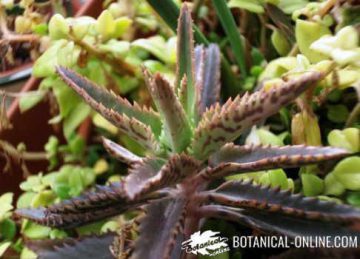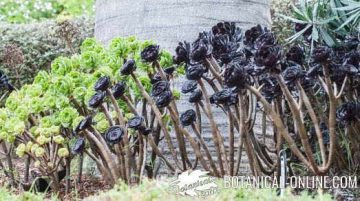Contents
How to grow cacti and other succulents from cuttings and division

Propagation of succulent plants
Succulent plants, also called succulents, are those that have developed thick or fleshy stems or leaves to increase their ability to store water. Among the most popular succulent crops are cacti, but there are other plants that are not cacti and that also have succulence as a mechanism of adaptation to dry climates, or to soils with little capacity to retain water.
How can we reproduce our succulent plants?
Succulent plants can reproduce in different ways:
- Through cuttings
- Through division
- Through seeds
- Through grafts
Among the most common ways of reproducing them we have cuttings and division. This guide explains how to multiply a cactus and other types of succulent plants from cuttings and division. For other types of reproduction, consult the listing below.
Reproduction of cacti and succulents using cuttings
By means of cuttings, in this way we will obtain specimens that will be genetically the same as the plant from which the cutting was obtained with all its virtues or defects. This may be convenient in some cases or inconvenient in others. For example, if we have a very beautiful or very rare cactus and we want the result to be a clone of the original, sometimes we have no choice but to reproduce by cuttings.
This is mandatory in some succulent plants without flowers or with sterile flowers.
When cuttings are made
Cuttings will be carried out in the growing season, that is, during the spring, except when it comes to plants that grow in areas with rainy winters , as occurs in certain succulent plants from Southwest South Africa, where winter (June to August) coincides with the rainy season. This occurs with certain South African plants of the genera:
- Sempervivum (Sempervivum hirta, Sempervivum sobolifera, etc.)
- Sedum (Sedum aizoon, Sedum ternatum etc.)
- Opuntia (Opuntia cymochila, Opuntia basilaris, etc.)
- Echinocereus (Echinocereus reichenbachii, etc.). )
- Lewisia (Lewisia cotyledon, Lewisia rediviva, etc.)
- Hesperaloe (Hesperaloe parviflora)
- Yucca (Yucca brevifolia, etc.)
- Agave (Agave havardiana, Agave parryi, etc.).
A similar area is found in the center of Chile, this is called the shrub spinal of succulent and xerophytic plants of the Mediterranean climate. This ecosystem has a mild and rainy climate in winter (from June to August). In this area, we have succulents as well known as the Echinopsis chiloensis cactus or the Bromeliads Puya berteroniana and Puya coerulea var. violacea.
Reproduction of succulents by cutting step by step

Once cut, the cuttings should be kept in the shade and at an ambient temperature of around 20 ºC. To facilitate rooting, a “cuttings or propagator kit” can be purchased that better maintains adequate ambient heat and humidity. If this gadget is not available, other home systems can be developed.
A very simple one consists of placing some sticks of about 20 cm around the ground, next to the edge of the pot and others inside to support a plastic that will cover the entire set. You can also take advantage of a large plastic bottle to cut it in half and place it in the shape of a bell on the pot.
Types of cactus and succulents cuttings
We have the following types of cuttings:
- Stem cuttings
- Leaf cuttings
Reproduction of succulents by cuttings step by step

- With a well-sharpened and disinfected knife, we will cut a piece of the stem, making the cut very smooth, without cracking the stem.
- Later, although it can be planted directly in the ground, it will be better to let the cut dry keeping the plant for one or two weeks at shade for the wound to heal. In many species this favors the formation of roots and prevents the cut from rotting. To favor the formation of roots, the cut can be impregnated with rooting hormones.
- Once the cutting has been prepared, it must be introduced into a soil prepared for this purpose. Although a mixture of equal parts peat and sand is often used, it is best to plant it directly on sandy soil by inserting a planting cone or stick, and then placing the cutting in the hole.
- Press the sand carefully so that the cutting is fixed. Wait a couple of weeks to water. Subsequently keep the soil moist, watering regularly.
- Once it has taken root, which can occur between 15 and 50 days later, transplant to the final place, which has been prepared with the mixture of suitable components.
Leaf cuttings in cacti and other succulent plants

Leaf cuttings of cacti and other succulent plants Some species within the genera of succulents, such as many epiphytic cacti, Sedum, Adromischus, Echeveria, Crassula or Kalanchoe, prefer leaf cuttings to stem cuttings. Some of these species have special leaves that spontaneously fall on the ground and take root producing new plants:
- For the leaf cuttings, a fragment of the leaf is cut at the point where it joins the stem.
- Afterwards, the cut is allowed to dry for a week and a finger is inserted into the ground following the same steps as for the stem cutting.
- From the planted leaf new roots will emerge and, later, new seedlings.
Kalanchoe, an example of leaf cutting
It is an endemic plant of Madagascar that, in warm areas of southern Europe, has adapted perfectly to become an invasive plant. If a specimen is available in a garden or terrace, it quickly invades the ground or the rest of the pots, forcing the gardener to continually pluck the new shoots.
As it was said, some species have special leaves that spontaneously fall into the ground and take root producing new plants. Among the most outstanding is the devil’s backbone (Kalanchoe daigremontiana) that produces numerous small leaflets on the edges of the leaves, which, when they fall, take root producing new plants.


See in the photo below detail of the plant and increased detail of these leaves.
Reproduction of cacti and succulents by division
Division allows to obtain plants directly formed from the mother plant. Therefore it represents a safer and faster way to have identical specimens to the plant from which they were obtained. At the same time, it favors the growth and health of the mother plant since we separate a fragment of the material that was part of it.
Among the main division methods we have: the bush division and the division of shoots.
Tuberous root division
Some cacti develop tuberous roots or expand to matte so that they can reproduce by separating a fragment from the mat or root. Many of these plants, like members of the asclepediaceae, when removed from their pots, are easily separable because they contain a set consisting of several semi-detached stems with their own roots. It is enough to exert a small pressure to obtain individual stems that can be planted in a new pot.

Other times it will be necessary to exert a higher pressure or use a well-sharpened and disinfected knife to separate certain bushes that form a thick group.
In the case of some succulents with tuberous roots, it will be necessary to make a clean cut, so that we obtain a fragment containing a group of roots and buds in good condition. After performing any of these divisions, it is advisable to allow the wounds to heal for a few days. You can also apply some kind of fungicide to prevent the development of fungi.
Once the wound is healed, it will be planted in the ground in a hole with the appropriate soil. It is convenient to carry out these operations when the plant is not growing and with the roots completely dry, to avoid the loss of sap.

Some succulent plants develop other stems at the base of the stems that grow directly from them. These formations can be used to obtain new specimens.
In this case, we will separate the shoot from the main stem by exerting pressure on it. We will apply some fungicide on the two separation zones, both on the mother plant and on the bud, and we will let the wounds on the new stem dry for a few days. When the area has healed, we will plant it in a new pot with the soil prepared for succulent plants.
![]() More information on succulent plants
More information on succulent plants








